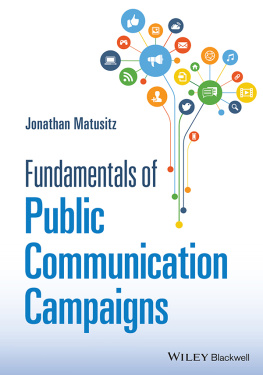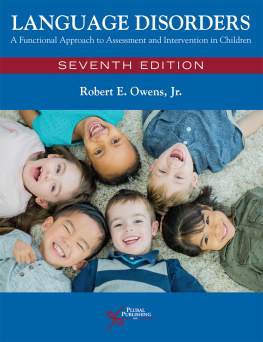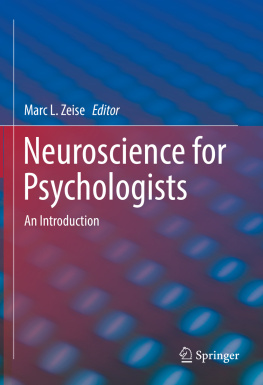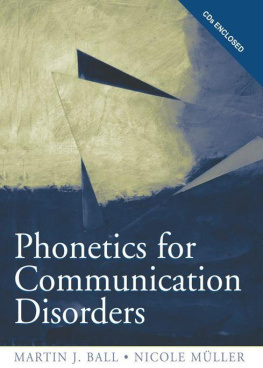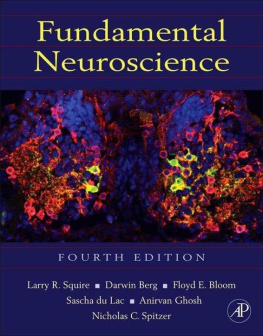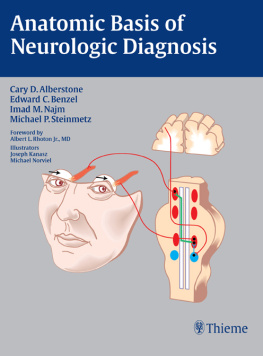NEUROSCIENCE FUNDAMENTALS for Communication Sciences and Disorders
NEUROSCIENCE FUNDAMENTALS for Communication Sciences and Disorders
RICHARD D. ANDREATTA, PHD


5521 Ruffin Road
San Diego, CA 92123
e-mail:
Website: http://www.pluralpublishing.com
Copyright 2020 by Plural Publishing, Inc.
Typeset in 10.5/12 Adobe Garamond Pro by Flanagans Publishing Services, Inc.
Printed in Canada by Friesens Corporation.
All rights, including that of translation, reserved. No part of this publication may be reproduced, stored in a retrieval system, or transmitted in any form or by any means, electronic, mechanical, recording, or otherwise, including photocopying, recording, taping, Web distribution, or information storage and retrieval systems without the prior written consent of the publisher.
For permission to use material from this text, contact us by
Telephone: (866) 758-7251
Fax: (888) 758-7255
e-mail:
Every attempt has been made to contact the copyright holders for permission to use material originally printed in another source. If any credits have inadvertently been overlooked, the publisher will gladly make the necessary arrangements at the first opportunity.
Disclaimer: Please note that ancillary content (such as documents, audio, and video, etc.) may not be included as published in the original print version of this book.
Library of Congress Cataloging-in-Publication Data:
Names: Andreatta, Richard D., author.
Title: Neuroscience fundamentals for communication sciences and disorders / Richard D. Andreatta.
Description: San Diego, CA : Plural Publishing, [2020] | Includes bibliographical references and index.
Identifiers: LCCN 2018049910| ISBN 9781597568890 (alk. paper) | ISBN 1597568899 (alk. paper)
Subjects: | MESH: Central Nervous System--physiology | Central Nervous System--anatomy & histology | Sensation--physiology | Perception--physiology
Classification: LCC QP376 | NLM WL 300 | DDC 612.8/2--dc23
LC record available at https://lccn.loc.gov/2018049910
Contents
Richard D. Andreatta
Richard D. Andreatta
Richard D. Andreatta
Richard D. Andreatta
)
)
)
)
)
)
)
)
)
)
)
)
)
)
)
)
)
)
)
Richard D. Andreatta
Richard D. Andreatta
Richard D. Andreatta
Richard D. Andreatta
Richard D. Andreatta and Nicole M. Etter
Richard D. Andreatta
)
Richard D. Andreatta
Patrick O. McKeon
Stephen M. Tasko
)
)
)
Jessica D. Richardson and Sarah Grace H. Dalton
Anne D. Olson
The idea for this book has been running around in my mind since I first started university teaching back in 2000. All that was needed was an opportunity to get this idea off the ground and realized. That opportunity came in late fall 2014 when I received an email from Valerie Johns, Executive Editor at Plural Publishing, asking whether I would be interested in developing a high-quality neuroscience textbook for communication sciences and disorders students. As is evident by the book you are holding and reading right now, I grabbed that amazing opportunity and have spent the better part of the last 3 years working toward its realization and completion. I hope you enjoy the results!
Neuroscience Fundamentals for Communication Sciences and Disorders (NFCSD) was developed with three personal goals in mind. First and foremost, NFCSD was developed to provide senior undergraduate and graduate students in communication sciences and disorders (CSD) programs (as well as students in Doctor of Audiology [AuD] programs) with a richly illustrated, comprehensive, yet highly readable and accessible textbook covering the neuroanatomy and neurophysiology of the human nervous system. NFCSD was conceived and written as a brain and behavior style of textbook, while also ensuring coverage of essential neuroanatomy in an integrative fashion. My central motivation for producing this book was (and continues to be) to help students develop a deep understanding and appreciation of critical brainbehavior relationships that can impact and help inform their careers as rehabilitation specialists for patients and clients with speech, language, and hearing disorders. Valuing the critical role of the nervous system in the behaviors, perceptions, and cognitive functioning of someone with a communication disorder is something I believe is central to the development and implementation of effective and efficient evidence-based treatments.
Second, I aspired to write a textbook for practicing clinicians who want a comprehensive guide to the inner workings of the nervous system and its processes. A reference book of this type is always useful in ones professional library. Clinicians need a reference book that can be appreciated, read, and understood without having to take another formal course in the subject matter. My hope is that the accessibility of the writing and the illustrations can allow those who have been out of school for a while to use the material in this book to directly inform their practice. Aside from its direct use for informing patient care, the book can also be used for client and caregiver educational purposes; the illustrations and the explanatory analogies may be ideal for helping clients better understand the brain-based nature of their disorder.
Finally, my third personal goal was to write a textbook for faculty who are responsible for teaching neural bases of speech and language courses, but who do not themselves have specific expertise in this area. Larger programs in CSD usually have someone on their faculty with specific neuroscience experience, but medium- to smaller-sized programs may not. I wanted this textbook to be a resource or guide for any faculty colleague of mine who is in the challenging position of having to develop a class in and/or teach a neural bases course, but does not feel comfortable or confident in doing so. If this happens to describe your circumstances, then this textbook can certainly be of help to you. For faculty in this position, think of the textbook as more of a users guide to help you develop lectures and course content. Feel free to use the analogies and examples scattered throughout the book as your own when teaching; customize them as you wish.
In closing, let me say that I believe textbooks should be dynamic and living things that evolve and change as we learn more about our subject matter. The contents of this book are as current as possible, and every effort has been made to check and cross-check its accuracy against several sources. Despite these efforts, there will be errors in the book, and for these I apologize in advance; the fault for these errors is mine, and mine alone. To students, clinicians, and adopting faculty alike, if you find errors in the book, please feel free to e-mail me at , and I will compile a list of corrections to make upon any future editions of the book that may get published.
Next page

